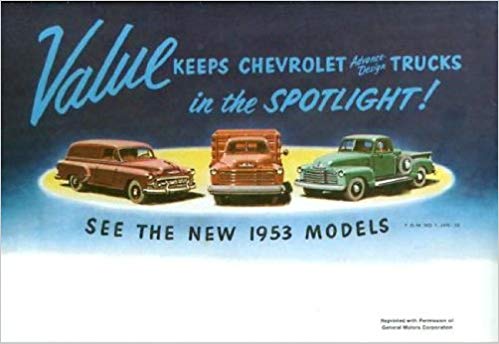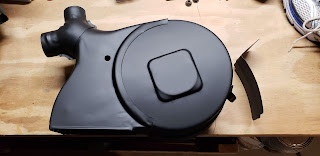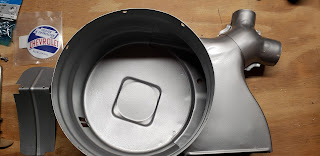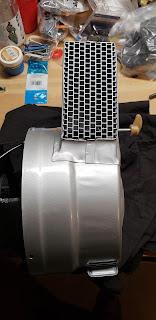Hello Gray Ghost Fans!
Well, it's mid-winter and you know what that means. Time for small projects to try and keep things moving forward while we wait for the warmer weather. Now, these aren't time wasters, these are things that need to be done, but are always lower on the list.
One of those projects is to either adjust or make a new connecting rod that goes between the gas pedal and the engine block. This rod is a part of the overall linkage system that controls speed through the carburetor. The reason for having to do this is that the replacement engine block that I have only has one mounting point for the pivot (also a part of the overall linkage) and it is in a different place on the block than the engine that I am removing. The mounting point for the pivot is about 3" closer to the firewall than the original engine. That means that I could shorten the original rod or make a new one. I chose to try and make a new one, so that I could preserve the original one. Whenever possible, I try to keep original parts intact, even if I choose to use new parts. The original rod and the proposed replacement look like this:
The original rod is in the top of the pic. The ball at the top is what mounts to the back of the gas pedal. You can see that the top portion of the rod is thicker than the bottom portion. The bottom portion is 3/8" diameter. The drawing below the rod is an outline of the rod's shape with hash marks added every 1/4". I transferred the hash marks to the new rod, which is 3/8" the entire length. The round part on top of the rod is a gas strut mounting ball that I bought for this purpose. It came in metric sizes, but the ball measured the same as the original ball. To make it fit, I got out the old tap and die set and added M6-1.0 threads to the rod. Piece of cake, by now.
The thought is to put the rod into the bench vise, which is almost closed around the rod and make small bends at each hash mark. The cumulative effect of many small bends is hoped to replicate the sweeping curve of the original rod. To easily bend the 3/8" steel rod, I used a piece of iron pipe slipped over the steel rod..."give me a big enough lever and I can move the world"...works! At any rate, the first pass through the process resulted in this:
Holy Cow! This might actually work! Time for a second pass. It resulted in this:
OK, progress, but slow. And that's alright! I only want to do this once! Time for a third pass. That resulted in this:
Almost there. One more time! That resulted in this:
TaDa! That is pretty darn close. But wait, the end of the rod isn't quite at the same angle as the original after all that bending. Will it even fit and be close to the linkage? Time for a test fit.... It looked like this:
Here we can see the new rod coming through the firewall, after I attached it to the gas pedal. The rod is resting on top of the fitting for the oil pressure gauge and remote oil filter. The pivot mounting point is center frame and the rod goes right past it. That means that it is plenty long enough and actually will work! A side view of the rod, in position with the current pivot mounting point looks like this:
Remember, the new engine has the mounting point about 3" closer to the firewall. That means that the new rod is way longer than it needs to be. But, to void screwing it up now, I'm going to leave the rod as is, until the replacement engine is in the truck. Then I'll measure exactly where the rod needs to be bent to fit the new engine. Once bent, a quick trim of the rod to the correct length and drilling a small hole in the end for a cotter pin will be all that's needed. At that time, I'll also add some thread locker to the rod and permanently mount the ball end to the rod.
Not too shabby, I'd say. I guess the jury will be out until I actually use the new rod to work the accelerator. The only concern that I have is the use of a 3/8" rod for the entire length and not doing what GM did and use two different thicknesses. Truthfully, I don't see the rod bending, but if it does, I can always go back to the original rod and make it fit the new engine.
That's all for now. Here's looking forward to some warmer weather!
All about working on and restoring my 1953 Chevy 3100 (1/2 ton) pickup truck including the inline 6 235 engine
1953 chevy truck ad

Sunday, January 27, 2019
Wednesday, January 9, 2019
Gray Ghost Heater Decalcomania
Hello Gray Ghost Fans!
It's been a long time since my last post. In fact, a little too long. However, I do have my reasons...like being busy on an important woodworking project for my family. So while it's a departure from the Gray Ghost, here's a shot of the project:
It's a dresser! A purpose built, built to fit the space dresser. It stands about 51" tall and 48" wide and allows for some better organization. It is built in the old crate furniture style, so that it matches the beds that were already in the room. Family will always come first, so when the need was identified, I got on it.
Time passes and it is then onto the Christmas season! My big present from my wife to me was a new heater core from a company called Brassworks! It looks like this:
It is designed to be a drop in replacement for the old style, hard to repair round heater core found in my truck. So once the holidays were over, I was free to start work on the restoration of the truck's heater.
Now, to level set the task, here's a shot of the heater, as it sat in the truck on the day that I got it:
An interesting side note about this heater: based on the Chevrolet decal, this is a 1954 model heater. It is totally possible that the original owner added the heater after the new model year started, resulting in a 1954 model year heater going into a 1953 truck. And yes, heaters were optional equipment!
Anyway, it looks pretty rough, but just how rough? Here are the pics of the heater after I got it out of the truck:
You can see the worst of it is the bracket that holds the heater core inside the heater box. Of course it's the worst! I only have to reuse the bracket and the box, why shouldn't they be rough. In fact, the bracket was bad enough that I decided to use a different one that I had already salvaged from the junkyard a couple years ago.
The first step in the process is to separate the bracket from the old core. To do this, you have to de-solder it. My micro torch wasn't up to the task, so I went out and got a MAP gas torch, which made quick work of it! After separating the two parts, I had to clean all of the old solder off of the bracket. The process looked like this:
After cleaning the solder, it looked like this:
Clearly, even this bracket would need some blasting, so when I got a warm day, that's what I would do: blast everything that needed it.
Well, I finally got my warm day, which meant it was time to disassemble the old heater box and all of its' components so that they could be blasted. Here's how it all looked after blasting:
A whole lot better, but.... Clearly there is still some pitting that I can't seem to get clean. I'm guessing that the sandblasting grit was too large to get down into those spots. So, I spent some quality time with various grits of sandpaper, working on specific spots. Still, there would be some pitting that I just couldn't get, for fear of taking out too much metal. Time for an experiment! Since the majority of the rust was actually gone, I thought I'd try the Rustoleum brand rust encapsulator to see how it would work.
So off to prime my newly cleaned, 65 year old parts! Let me just say wow to the Rustoleum rust encapsulator! I have no idea if it will work to keep the rust from reappearing, but what an awesome primer! My primed parts came out like this:
Yes, some of the really bad pitting is still visible, but I couldn't have been happier with the priming results!
Now that the metal is protected, I had a little fitting work to do to mate the old bracket to the new heater core. This entailed drilling 4 holes into the heater core flanges, avoiding the heater core tanks (it is made like a mini radiator with tanks on either side). I used #6-32 x 1/2" nuts and bolts (with lock washers) to secure the bracket to the heater core. Once I was happy with the holes, I painted the bracket a satin black.
Now the $64 question: what color to paint the heater box and air diverter part? The original pic isn't much help:
But...maybe there was a clue under that 65 year old decal...
Holy crap! It's actually hammertone silver! That can't be, let's check for another protected area and see if that is real!
Look closely at the right side of the heater box and the heater hose connection points. Hammertone silver! Well alright, hammertone silver it is!
Laying down a coat of that paint on top of that awesome primer was easy! Getting the hammertone effect was a little harder. After using it, I think that the key to the hammertone effect is to lay down a thicker coat of paint than you would normally lay down. That would be fine, if the parts weren't hung on a rack for spraying.... Anyway, the silver looks great:
Here you can see all of the parts that will be assembled into the heater box, minus the heater core assembly. Assembling the control rod with washers and spring into the box and onto the diverter was a bit fiddly, but I eventually got it without breaking anything! The key to this was taking a pic of the assembly before disassembling it! Before and after:
Obviously, in the first pic I've already removed the diverter. But I had the sense to get a photo of the parts in the correct order and placement before removing them! Getting the diverter wedged between the washers and spring was a challenge, but it is manageable. Onto assembling the heater core and bracket. This was easy, as I'd already done it before painting. Once done, it looked like this:
In the bottom pic you can see that I wedged in a round grommet into a rectangular hole. I felt like it needed something, so I winged it and got a larger Grommet from the store and it mostly fits. In these pics you can see the #6 nuts and bolts.
On to the Decalcomania! Normally I would look to the Factory Assembly Manual (FAM) for the drawing that showed exactly how and where to place the decal. However, since the heater is a dealer installed option, it isn't in the FAM. It's in the accessory installation manual. A manual that I don't have! Looking at the original decal and a photo from an online accessory installation manual, it appeared as though the writing was supposed to be parallel to the square shape embossed into the heater box. That way, when the heater was installed into the truck, it would be rotated into a jaunty angle. Anyway, here's how mine now looks:
Quite the transformation! I'll keep this out of the truck until after I do the engine swap. I figure having those tubes from the heater core sticking out into the engine bay would just be an invitation to damage the new core.
The knob on the control rod is original to the heater. It is still kind of dingy looking and it has a couple of large cracks in it, but they don't make them anymore so I'm sticking with it for now. If it breaks, I have a NOS replacement, but it too has cracks. Also, visible in the above pics are the two wires for powering the fan. They came installed in a non-standard connector and looked like this:
I depopulated the nonstandard connector and will purchase both sides (male and female) of a standard connector. It's all a part of the process.
That's all for now. Happy New Year, Gray Ghost Fans!
It's been a long time since my last post. In fact, a little too long. However, I do have my reasons...like being busy on an important woodworking project for my family. So while it's a departure from the Gray Ghost, here's a shot of the project:
It's a dresser! A purpose built, built to fit the space dresser. It stands about 51" tall and 48" wide and allows for some better organization. It is built in the old crate furniture style, so that it matches the beds that were already in the room. Family will always come first, so when the need was identified, I got on it.
Time passes and it is then onto the Christmas season! My big present from my wife to me was a new heater core from a company called Brassworks! It looks like this:
It is designed to be a drop in replacement for the old style, hard to repair round heater core found in my truck. So once the holidays were over, I was free to start work on the restoration of the truck's heater.
Now, to level set the task, here's a shot of the heater, as it sat in the truck on the day that I got it:
An interesting side note about this heater: based on the Chevrolet decal, this is a 1954 model heater. It is totally possible that the original owner added the heater after the new model year started, resulting in a 1954 model year heater going into a 1953 truck. And yes, heaters were optional equipment!
Anyway, it looks pretty rough, but just how rough? Here are the pics of the heater after I got it out of the truck:
You can see the worst of it is the bracket that holds the heater core inside the heater box. Of course it's the worst! I only have to reuse the bracket and the box, why shouldn't they be rough. In fact, the bracket was bad enough that I decided to use a different one that I had already salvaged from the junkyard a couple years ago.
The first step in the process is to separate the bracket from the old core. To do this, you have to de-solder it. My micro torch wasn't up to the task, so I went out and got a MAP gas torch, which made quick work of it! After separating the two parts, I had to clean all of the old solder off of the bracket. The process looked like this:
After cleaning the solder, it looked like this:
Clearly, even this bracket would need some blasting, so when I got a warm day, that's what I would do: blast everything that needed it.
Well, I finally got my warm day, which meant it was time to disassemble the old heater box and all of its' components so that they could be blasted. Here's how it all looked after blasting:
A whole lot better, but.... Clearly there is still some pitting that I can't seem to get clean. I'm guessing that the sandblasting grit was too large to get down into those spots. So, I spent some quality time with various grits of sandpaper, working on specific spots. Still, there would be some pitting that I just couldn't get, for fear of taking out too much metal. Time for an experiment! Since the majority of the rust was actually gone, I thought I'd try the Rustoleum brand rust encapsulator to see how it would work.
So off to prime my newly cleaned, 65 year old parts! Let me just say wow to the Rustoleum rust encapsulator! I have no idea if it will work to keep the rust from reappearing, but what an awesome primer! My primed parts came out like this:
Yes, some of the really bad pitting is still visible, but I couldn't have been happier with the priming results!
Now that the metal is protected, I had a little fitting work to do to mate the old bracket to the new heater core. This entailed drilling 4 holes into the heater core flanges, avoiding the heater core tanks (it is made like a mini radiator with tanks on either side). I used #6-32 x 1/2" nuts and bolts (with lock washers) to secure the bracket to the heater core. Once I was happy with the holes, I painted the bracket a satin black.
Now the $64 question: what color to paint the heater box and air diverter part? The original pic isn't much help:
But...maybe there was a clue under that 65 year old decal...
Holy crap! It's actually hammertone silver! That can't be, let's check for another protected area and see if that is real!
Look closely at the right side of the heater box and the heater hose connection points. Hammertone silver! Well alright, hammertone silver it is!
Laying down a coat of that paint on top of that awesome primer was easy! Getting the hammertone effect was a little harder. After using it, I think that the key to the hammertone effect is to lay down a thicker coat of paint than you would normally lay down. That would be fine, if the parts weren't hung on a rack for spraying.... Anyway, the silver looks great:
Here you can see all of the parts that will be assembled into the heater box, minus the heater core assembly. Assembling the control rod with washers and spring into the box and onto the diverter was a bit fiddly, but I eventually got it without breaking anything! The key to this was taking a pic of the assembly before disassembling it! Before and after:
Obviously, in the first pic I've already removed the diverter. But I had the sense to get a photo of the parts in the correct order and placement before removing them! Getting the diverter wedged between the washers and spring was a challenge, but it is manageable. Onto assembling the heater core and bracket. This was easy, as I'd already done it before painting. Once done, it looked like this:
In the bottom pic you can see that I wedged in a round grommet into a rectangular hole. I felt like it needed something, so I winged it and got a larger Grommet from the store and it mostly fits. In these pics you can see the #6 nuts and bolts.
On to the Decalcomania! Normally I would look to the Factory Assembly Manual (FAM) for the drawing that showed exactly how and where to place the decal. However, since the heater is a dealer installed option, it isn't in the FAM. It's in the accessory installation manual. A manual that I don't have! Looking at the original decal and a photo from an online accessory installation manual, it appeared as though the writing was supposed to be parallel to the square shape embossed into the heater box. That way, when the heater was installed into the truck, it would be rotated into a jaunty angle. Anyway, here's how mine now looks:
Quite the transformation! I'll keep this out of the truck until after I do the engine swap. I figure having those tubes from the heater core sticking out into the engine bay would just be an invitation to damage the new core.
The knob on the control rod is original to the heater. It is still kind of dingy looking and it has a couple of large cracks in it, but they don't make them anymore so I'm sticking with it for now. If it breaks, I have a NOS replacement, but it too has cracks. Also, visible in the above pics are the two wires for powering the fan. They came installed in a non-standard connector and looked like this:
I depopulated the nonstandard connector and will purchase both sides (male and female) of a standard connector. It's all a part of the process.
That's all for now. Happy New Year, Gray Ghost Fans!
Subscribe to:
Posts (Atom)













































